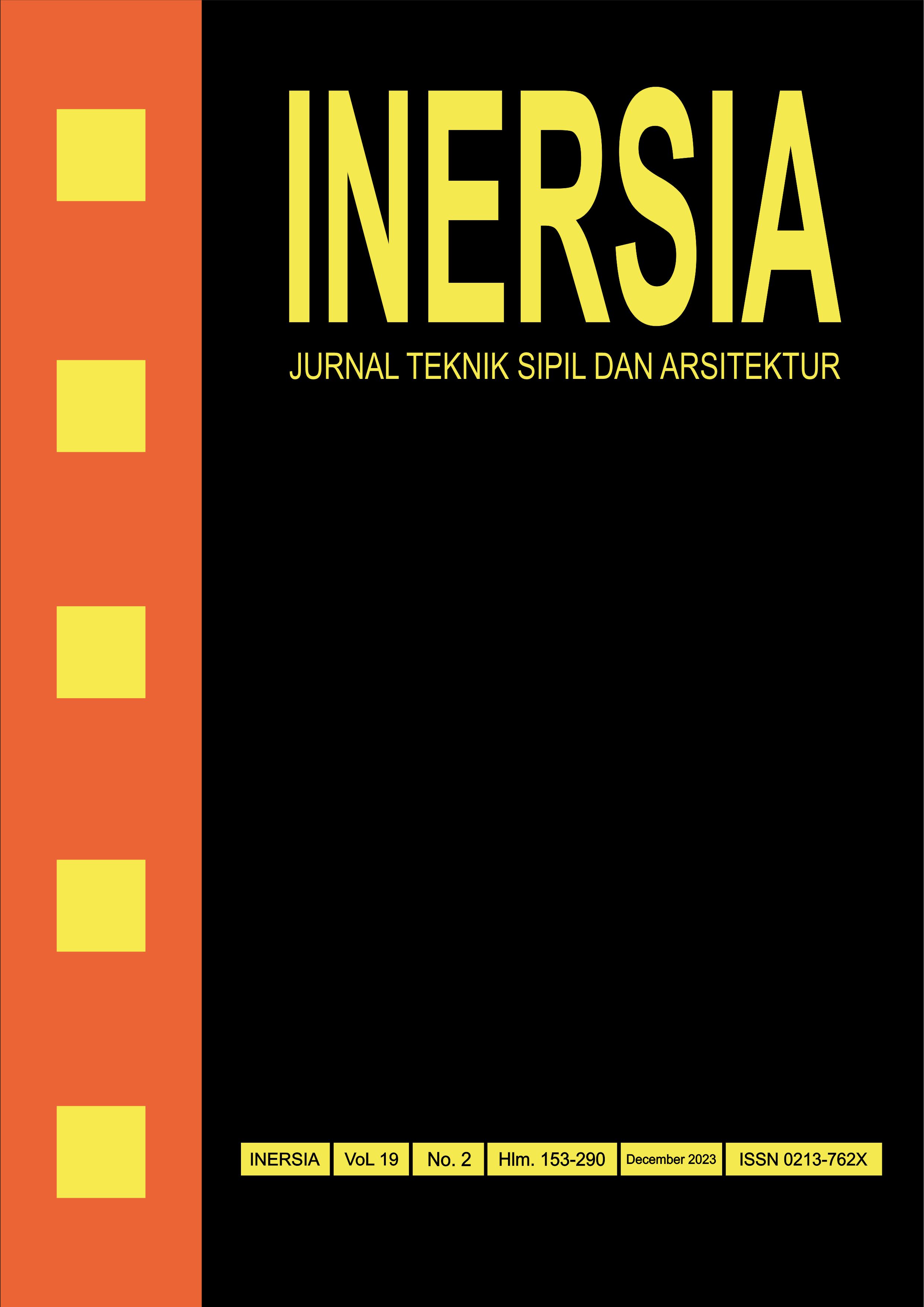The Mechanism of Rainfall-Induced Landslide Around Railway Tracks in Central Java Province, Indonesia
DOI:
https://doi.org/10.21831/inersia.v19i2.66835Keywords:
Mass movement, Rainfall intensity, Water infiltration, Remote sensing, Tension crackAbstract
Landslide is one of the most disastrous natural hazards in Indonesia, causing significant fatalities and economic losses. Landslides can be triggered by several factors, such as rainfall, earthquakes, soil conditions, and others, where each landslide event has its own triggering and controlling factors. A progressive landslide occurred on the Central Java railway line which resulted in damage to the double-track railway as a transportation infrastructure. The objective of this paper is to understand the process and triggering factors of the landslide. Information was collected through field investigations and measurements based on drilling results at 3 points, geophysical surveys at 5 lines, and laboratory testing of several soil samples. Geological and geotechnical settings, topography, lithology, hydrogeology, and rainfall data of the area were analyzed. Aerial photographs and other remote sensing data were used to evaluate and discuss the information. Landslides in the study area occurred in stages, starting with the formation of a tension crack, followed by two landslides over five months. The results show that the clay material that dominates the study area is the dominant controlling factor of a landslide, triggered by long-duration, low-intensity rainfall. Rainwater entering through tension cracks increases moisture content, adding load to the slope and triggering landslides. Furthermore, the train's external load on the slope also contributes to the occurrence of landslides. The static and cyclic load of the train causes changes in the slope's pressure balance, generating a force that drives the downslope soil. Further analysis was performed using back analysis method with the limit equilibrium method to enhance understanding of slope stability parameters at the time of slope failure. The analysis was performed considering the rising groundwater level. A factor of safety (FS) value of 0.989 was obtained at the end of the simulation, indicating that the slope had failed.
References
D. S. Hadmoko, f. Lavigne, j. Sartohadi, p. Hadi dan winaryo, "landslide hazard and risk assessment and their application in risk management and landuse planning in eastern flank of menoreh mountains, yogyakarta province, indonesia," natural hazards, vol. 54, pp. 623-642, 2010.
J. Cepeda, h. Smebye, b. Vangelsten, b. Nadim dan d. Muslim, "landslide risk in indonesia, global assessment report on disaster risk reduction," isdr, 2010.
S. S. Kyi, t. D. Nguyen, k. Aoki, y. Mito, k. B. Suryolelono, d. Karnawati dan s. Pramumijoyo, "landslide risk microzonation by using multivariate statistical analysis and gis," nt. J. Jpn. Comm. Rock mech, vol. 3, no. 1, pp. 7-15, 2007.
Z. Umar, b. Pradhan, a. Ahmad, m. N. Jebur dan m. S. Tehrany, "earthquake induced landslide susceptibility mapping using an integrated ensemble frequency ratio and logistic regression models in west sumatera province, indonesia," catena, vol. 118, pp. 124-135, 2014.
M. J. Haigh, j. S. Rawat, m. S. Rawat, s. K. Bartarya dan r. P. Rai, "interactions between forest and landslide activity along new highways in the kumaun himalaya," forest ecology and management, vol. 78, no. 1-3, pp. 173-189, 1995.
M. T. J. Terlien, "he determination of statistical and deterministic hydrological landslide-triggering thresholds," environmental geology, vol. 35, pp. 124-130, 1998.
S. Bai, j. Wang, r. Bell dan t. Glade, "distribution and susceptibility assessments of landslide triggered by wenchuan earthquake at longnan," melbourne, australia, 2012.
J. W. Zhou, p. Cui dan x. G. Yang, "dynamic process analysis for the initiation and movement of the donghekou landslide-debris flow triggered by the wenchuan earthquake," journal of asian earth sciences, vol. 76, pp. 70-84, 2013.
X. Fan, g. Scaringi, q. Xu dan w. Zhan, "coseismic landslides triggered by the 8th august 2017 ms 7.0 jiuzhaigou earthquake (sichuan, china): factors controlling their spatial distribution and implications for the seismogenic blind fault identification," landslides, vol. 15, no. 5, pp. 967-983, 2018.
R. Kusumawardani, m. Chang, t. C. Upomo, r. C. Huang, m. H. Fansuri dan g. A. Prayitno, "understanding of petobo liquefaction flowslide by 2018.09. 28 palu-donggala indonesia earthquake based on site reconnaissance," landslides, vol. 18, p. 3163–3182, 2021.
N. Luo, r. J. Bathurst dan s. Javankhoshdel, "probabilistic stability analysis of simple reinforced slopes by finite element method," computers and geotechnics, vol. 77, no. 7, pp. 45-55, 2016.
Q. Ran, y. Hong, li dan j. Gao, "a modelling study of rainfall-induced shallow landslide mechanisms under different rainfall characteristics," journal of hydrology, vol. 563, no. 8, pp. 790-801, 2018.
J. Corominas, j. Moya, a. Ledesma, a. Lloret dan j. A. Gili, "prediction of ground displacements and velocities from groundwater level changes at the vallcebre landslide (eastern pyrenees, spain)," landslides, vol. 2, p. 83–96, 2005.
R. Rosso, k. M. Rulli dan g. Vannucchi, "a physically based model for the hydrologic control on shallow landsliding," water resources research, vol. 42, no. 6, 2006.
E. Conte, a. Donato, l. Pugliese dan a. Troncone, "analysis of the maierato landslide (calabria, southern italy)," landslides, vol. 15, p. 1935–1950, 2018.
D. Salciarini, j. W. Godt, w. Z. Savage, r. L. Baum dan p. Conversini, "modeling landslide recurrence in seattle, washington, usa," engineering geology, vol. 102, no. 3–4, pp. 227-237, 2008.
E. Conte dan a. Troncone, "simplified approach for the analysis of rainfall-induced landslide," journal of geotechnical and geoenvironmental engineering, vol. 138, p. 398–406, 2012.
C. D. Shackelford, c. K. Chang dan t. F. Chiu, "the capillary barrier effect in unsaturated flow through soil barriers," edomonton, ab, canada, 1994.
Y. Liu, z. Deng dan x. Wang, "the effects of rainfall, soil type and slope on the processes and mechanisms of rainfall-induced shallow landslides," applied sciences, vol. 11, no. 24, p. 11652, 2021.
R. E. Hunt, geotechnical investigation methods a field guide for geotechnical engineers, boca raton: crc press , 2007.
J. Torizin, "bivariate statistical method for landslide susceptibility analysis using arcgis," project of technical cooperation "mitigation of georisks" in bogor, bogor, 2011.
A. K. Lobeck, geomorphology, an introduction to the study of landscapes, new york: mcgraw-hill book company, 1939.
T. D. Thi dan d. D. Minh, "riverbank stability assessment under river water level changes and hydraulic erosion," water, vol. 11, p. 2598, 2019.
Google earth, 2000-2011-2013-2016-2019-2023. [online]. Available: https://earth.google.com/. [accessed 7 july 2023].
K. Klavon, g. Fox, l. Guertault, e. Langendoen, h. Enlow, r. Miller dan a. Khanal, "evaluating a process-based model for use in streambank stabilization: insights on the bank stability and toe erosion model (bstem)," earth surface processes and landforms, vol. 42, p. 191–213, 2017.
M. Jugie, f. Gob, c. Virmoux, d. Brunstein, v. Tamisier, c. Le coeur dan d. Grancher, "characterizing and quantifying the discontinuous bank erosion of a small low energy river using structure-from-motion photogrammetry and erosion pins," journal of hydrology, vol. 563, pp. 418-434, 2018.
Downloads
Published
How to Cite
Issue
Section
License
Authors who publish with INERSIA journal agree to the following terms:
- Authors retain copyright and grant the INERSIA journal right of first publication with the work simultaneously licensed under Creative Commons Attribution License (CC BY 4.0) that allows others to share the work with an acknowledgment of the work's authorship and initial publication in this journal.
- Authors can enter into separate, additional contractual arrangements for the non-exclusive distribution of the published version of the work (e.g., post it to an institutional repository or edit it in a book), with an acknowledgment of its initial publication in this journal.
- Authors are permitted and encouraged to post their work online (e.g., in institutional repositories or on their website) before and during the submission process, as it can lead to productive exchanges, as well as earlier and greater citation of published work.

INERSIA by https://journal.uny.ac.id/index.php/inersia was distributed under a Creative Commons Attribution 4.0 International License











